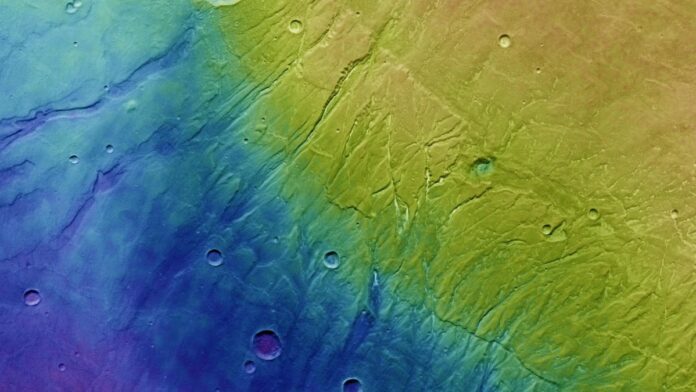The European Space Agency’s Mars Express spacecraft captured a stunning new view of the Red Planet’s complex surface geology.
The new image, taken using the orbiter’s High Resolution Stereo Camera (HRSC), focuses on the flanks of a vast volcanic plateau called Thaumasia Planum. Deep surface fractures and water-carved valleys stream down the side of this volcanic region, offering clues about Mars’ ancient past.
The surface features in this region appear very diverse, with the highest peaks rising a whopping 14,763 feet (4,500 meters) above the lowest areas of the plateau. Formed nearly four billion years ago, these peaks and valleys have experienced very little change, which is why they offer insight on what Mars was like back then.
Related: Mars is a ‘winter wonderland’ in this frosty (and stunning) image from space
The Thaumasia Planum region is believed to have formed in the very earliest days of Mars and is largely made up of immense lava flows that coated the surface in volcanic ash and dust before tectonic activity and running water created the fascinating features we see today, according to a statement from the European Space Agency (ESA).
“This time was a turbulent one, with many of Mars’ standout features just beginning to form,” ESA officials said in the statement (opens in new tab). “The Tharsis volcanoes, some of the largest in the solar system, are located near to Thaumasia Planum; the load and stress of these volcanoes forming may have prompted this region to begin fracturing, before these volcanoes then flooded the area with lava.”
(opens in new tab)
Back then, the planet likely experienced active tectonics, causing the ground to shift and move. In turn, as lava flowed over the surface and later cooled and solidified, the unstable ground created “wrinkle ridges” as the planet’s crust was compressed and stretched.
“One of the most substantial ridges is seen to the bottom-right of center [of the image] as an unsteady diagonal line scored into the surface,” ESA officials said in the statement.
Active tectonics would have also caused significant stresses in the planet’s crust, resulting in the deep surface fractures we see today. Known as Nectaris Fossae, these fractures stretch across the center of the new image and are believed to have formed in relation to the Valles Marineris canyon system — the largest in the solar system — located to the north of Thaumasia Planum.
In addition to once active tectonics, water is also believed to have flowed across the Martian surface some 3.8 billion years ago, cutting into the rock and carving out deep channels we know today as Protva Valles. These channels range from broad and superficial to deeply eroded valleys, like the dense patch captured in the bottom right of the new image.
However, “the origin of these water flows remains unclear; they appear to emerge at different heights, implying that water may have seeped through subsurface layers of Mars,” ESA officials said in the statement.
Follow Samantha Mathewson @Sam_Ashley13 (opens in new tab). Follow us @Spacedotcom (opens in new tab), or on Facebook (opens in new tab) and Instagram (opens in new tab).

